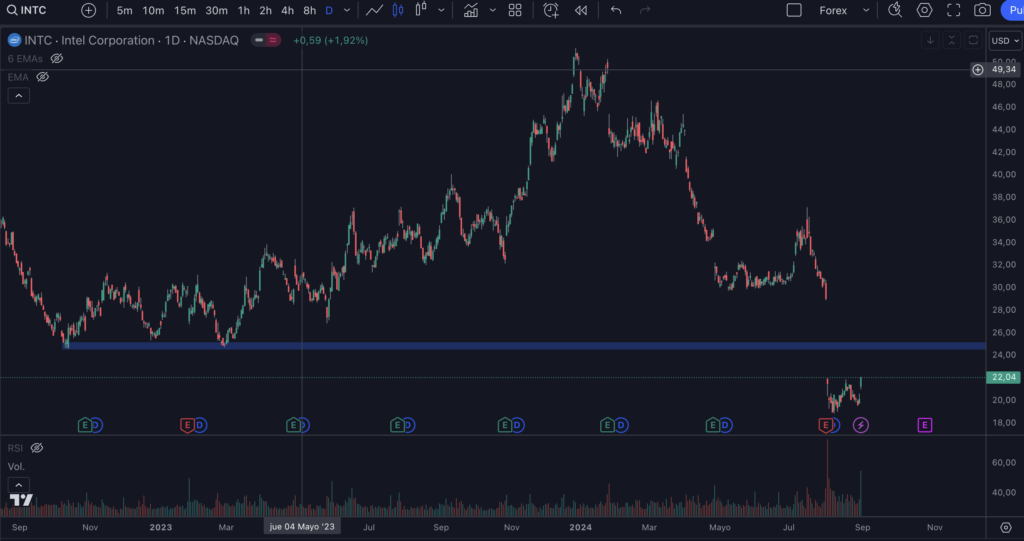
Investment Analysis: Is Intel a Good Opportunity in 2025?
Introduction
Intel Corporation (NASDAQ: INTC) has been a cornerstone of the tech industry for decades, especially in semiconductor manufacturing. However, in recent years, the company has faced significant challenges, such as increasing competition, delays in its manufacturing processes, and a loss of market share to rivals like AMD and NVIDIA. This analysis will review Intel's current numbers and evaluate whether the company remains an attractive option for investors.
Current Financial Status
At the close of the second quarter of 2024, Intel reported revenues of $14.8 billion, representing a 5% decrease compared to the same quarter the previous year. Despite this decline, the results were better than expected due to a rebound in data center demand and a slight increase in PC processor sales.
Intel's gross margin stood at 43%, a figure that, while respectable, has decreased from previous years when it regularly exceeded 50%. This decline is largely due to increased competition and the costs associated with transitioning to new manufacturing technologies.
The company's free cash flow (FCF) for the quarter was $3.2 billion, a positive sign that Intel is still generating enough cash to fund its operations and expansion projects. Intel also maintains a strong liquidity position, with around $24 billion in cash and equivalents, providing it with a financial cushion to face its challenges.
Challenges and Future Strategies
- Transition to Advanced Manufacturing Nodes: Intel has struggled to keep up with more advanced manufacturing nodes. However, the company is heavily investing in its 7nm process and beyond, with the expectation that these new nodes will be fully operational by 2025. If Intel can overcome these obstacles, it may regain some of its market share in key segments.
- Competition in the CPU Market: AMD and Apple have gained ground in the CPU market, especially in the high-performance segment. Intel is responding with its "Meteor Lake" and "Arrow Lake" processor lines, which will launch in 2024-2025. The reception of these new products will be crucial in determining whether Intel can effectively compete in this space.
- Expansion into New Markets: Intel is diversifying into areas such as artificial intelligence, autonomous vehicles, and the Internet of Things (IoT). The acquisition of Mobileye and its growing involvement in these sectors offer growth opportunities, though they also carry significant risks.
- Restructuring Initiatives: Under the leadership of Pat Gelsinger, Intel has launched a series of restructuring initiatives and announced plans to open its manufacturing facilities to third parties, in what is known as the "foundry" model. These actions could improve operational efficiency and generate new revenue streams in the long term.
Future Projections
- Revenue Growth: Intel's revenues are expected to grow at a compound annual growth rate (CAGR) of 3-5% over the next three years, driven primarily by demand in the data center and IoT sectors. However, this projection heavily depends on Intel's ability to overcome technical challenges and regain market share.
- Gross Margin: Intel's margins could stabilize around 45-48% as the company advances its 7nm manufacturing process and improves operational efficiency. However, a significant recovery to the historical levels of 50% seems unlikely in the short term.
- Cash Flow and Dividends: Intel should continue generating healthy cash flow, allowing it to maintain its dividend policy. Currently, Intel offers a dividend yield of approximately 4%, making it an attractive option for income-seeking investors.
Conclusion
Intel is at a crucial crossroads. Although it faces significant challenges, the company is also taking bold steps to restructure and position itself for the future. The key for investors will be to closely monitor the execution of its transformation plans, particularly regarding its manufacturing process and the reception of its new products.
For investors with a long-term investment horizon and moderate risk tolerance, Intel could represent an interesting opportunity, especially given its dividend yield and leadership position in the semiconductor market. However, it is essential to be aware of the inherent risks and uncertainty surrounding its ability to execute its ambitious restructuring plans.

Si quieres conocer otros artículos parecidos a Investment Analysis: Is Intel a Good Opportunity in 2025? puedes visitar la categoría Investment Analysis.


Deja una respuesta